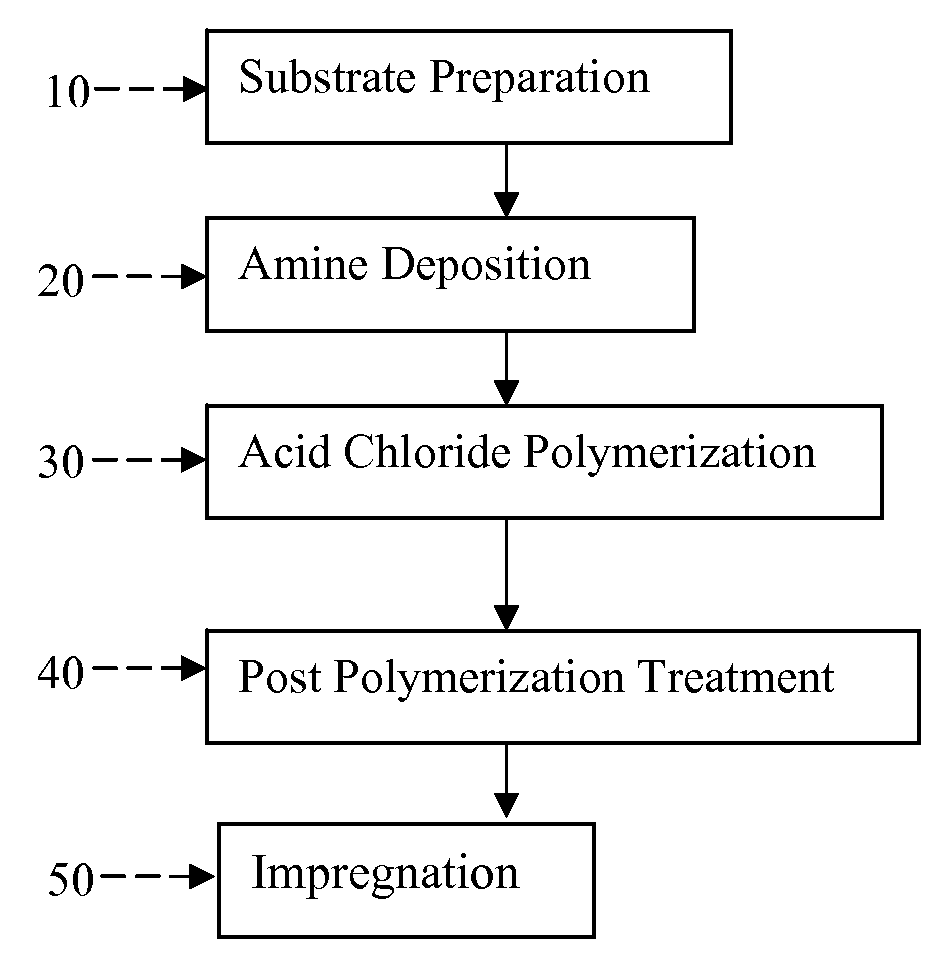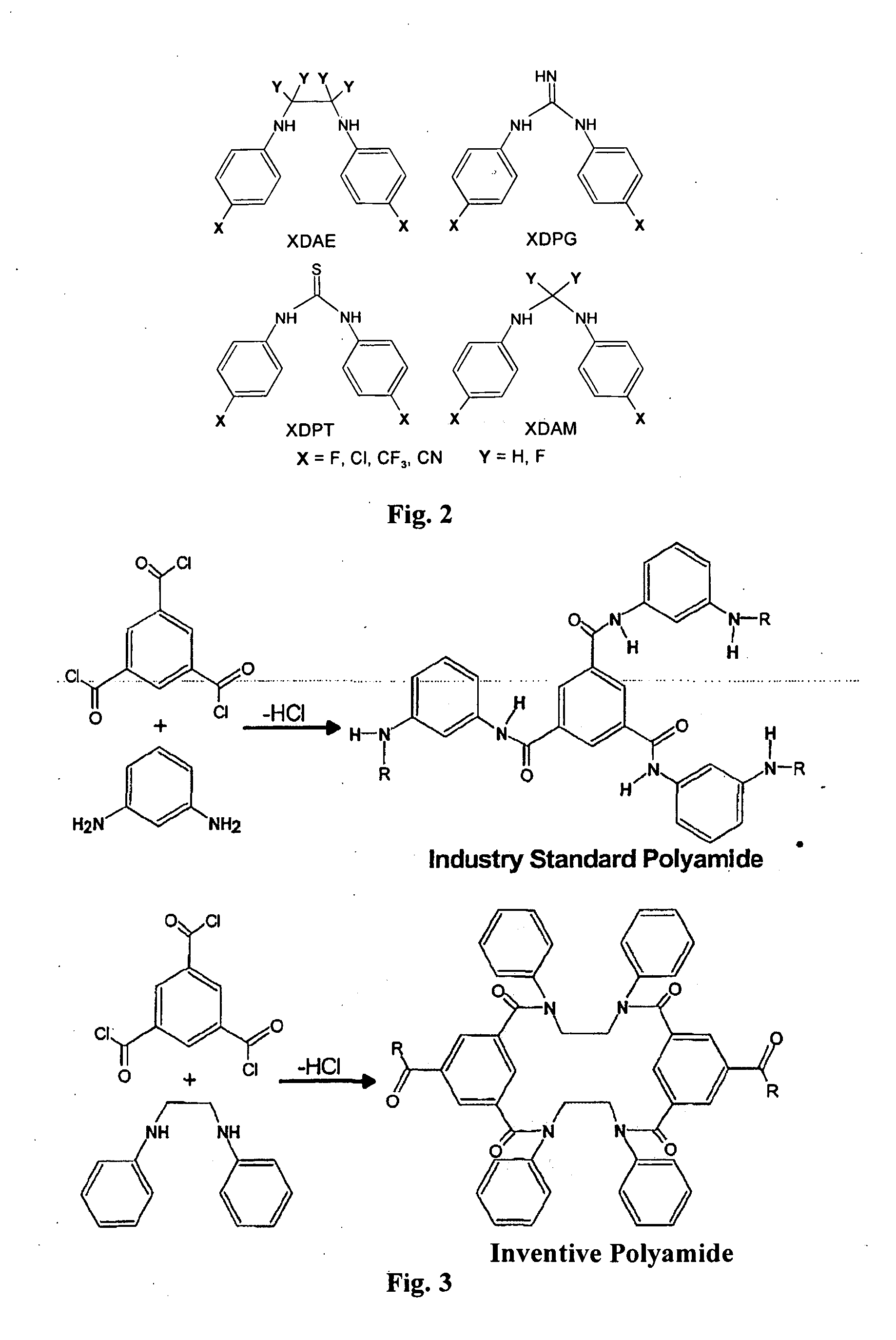Semipermeable polymers and method for producing same
a polymer membrane and membrane technology, applied in the direction of membranes, filtration separation, separation processes, etc., can solve the problems of low tolerance to strong oxidizers, high treatment costs, and high requirements for water treatment, and achieve the effect of suitable performance as a nanofiltration membran
- Summary
- Abstract
- Description
- Claims
- Application Information
AI Technical Summary
Benefits of technology
Problems solved by technology
Method used
Image
Examples
example 1
Membrane Fabrication
[0212]Thin film composite membrane samples were made for cross-flow filtration and chlorine tolerance testing following the disclosed method for interfacial polymerization on a microporous substrate. The deposition process emulates the general approach for large-scale thin film composite membrane fabrication which is illustrated in FIG. 7. Substrate 110, for example polysulfone, is fed to amine applicator tank 120. Solvent removal 130 is performed prior to entering acid chloride applicator tank 140. The substrate is rinsed at 150 by, for example, a series of rinse tanks #1, #2, #3, and #4. Following rinsing 150, drying is effected in one or more drying ovens 160. The polyamide composite membrane 170 may be rolled as shown in FIG. 7.
[0213]Flat sheet membrane samples for this program were fabricated using a deposition chamber apparatus. The deposition frame consists of an aluminum base plate and hinged pressure plate. Between the plates is clamped the polypropylene...
example 2
RO Membrane Testing
[0227]Membranes were fabricated numerous times (more than 700 total) and nearly all of these were laboratory tested in cross-flow filtration apparatus for desalination, chemical separations, metal ion filtration, and catalytic production of hydrogen peroxide directly from oxygen and hydrogen in a catalytic membrane reactor.
[0228]Membrane performance is typically characterized in terms of water flux and impurity rejection. Water flux is the rate of water volume per unit membrane area, and rejection is the relative change in impurity solute concentration from the feedwater stream to the permeate stream. Water permeation is driven by a pressure differential across the membrane greater than the osmotic pressure. Impurity rejection or membrane selectivity is measured as the rejection coefficient, R=[1−(Cp / Cf)]×100%, where Cp is the solute concentration of the permeate and Cf is the solute concentration of the feed solution.
[0229]The performance testing of membranes, wi...
example 3
TAC / DAE Piperazine (Type ER-HR1)—Effect of Polymerization Catalyst
[0235]The TAC+DAE / piperazine formulation (type ER-HR1, High Rejection type 1) gave high NaCl rejections of up to 82% and 10,340 ppm·h of chlorine tolerance (for NaCl rejection) with competitive permeate flux.
[0236]Membranes made using the DAE+TAC formulation showed the catalytic role halogens play in promoting the polymerization reaction as discussed earlier. FIG. 9 is a plot of MgSO4 Performance data for the DAE+TAC formulation made with catalyst, F89-45 (upper panel), and without catalyst (lower panel). Feed conditions: 2000 mg / L MgSO4, 20° C., 200 and 600 psig.
[0237]The results in FIG. 9 show a comparison of filter performance between membrane F89-45 produced with bromine catalyst and a DAE+TAC membrane made without bromine catalyst. Average salt rejection values (from continuous conductivity meter monitoring) are given as the high-density data points while separate analysis of individual ion rejection for Mg2+ and...
PUM
| Property | Measurement | Unit |
|---|---|---|
| Temperature | aaaaa | aaaaa |
| Density | aaaaa | aaaaa |
| Temperature | aaaaa | aaaaa |
Abstract
Description
Claims
Application Information
 Login to View More
Login to View More - R&D
- Intellectual Property
- Life Sciences
- Materials
- Tech Scout
- Unparalleled Data Quality
- Higher Quality Content
- 60% Fewer Hallucinations
Browse by: Latest US Patents, China's latest patents, Technical Efficacy Thesaurus, Application Domain, Technology Topic, Popular Technical Reports.
© 2025 PatSnap. All rights reserved.Legal|Privacy policy|Modern Slavery Act Transparency Statement|Sitemap|About US| Contact US: help@patsnap.com



